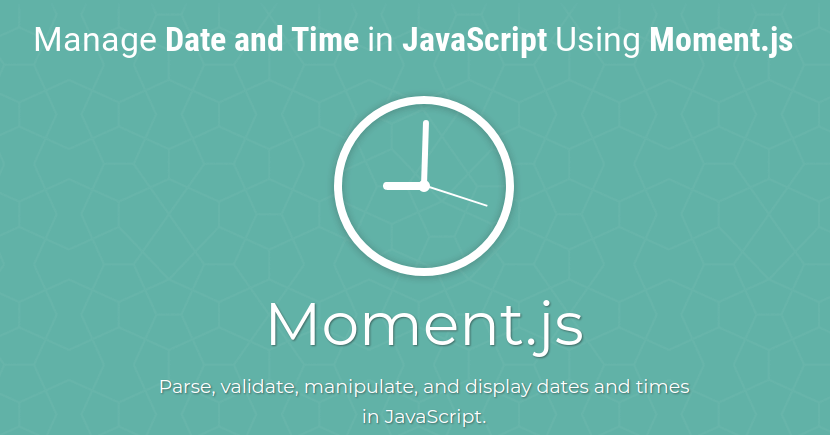Manage Date and Time in JavaScript Using Moment.js
In this article you will see how to manage date and time in JavaScript using Moment.js. How to use moment.js in JavaScript to manage Date and time. Moment.js is a lightweight JavaScript date library for parsing, validating, manipulating, and formatting dates. Working with times and dates in JavaScript has always been a sort of cumbersome. Often, native data methods are wordy and also the API is inconsistent. Thus, whenever you ask a data-related query on StackOverflow, often you would hear a reply ‘use Moment.js‘.
Understanding What is Moment.js
Moment.js is a JavaScript library that’s considered as a Swiss Army knife to work with dates. It enables you to validate, parsing, manipulating and displaying times and dates with the use of a concise and clean API. The library is available for free download from the home page of a project.
One of the development bottlenecks is the manipulating date, which developers have to undergo at one point in their careers. Efficient tools are extremely helpful and go a long way in taming the bottlenecks. Moment.js is a tool for JavaScript developers and is proven to be a great help in Javascript app development. It’s a free and open-source library of JavaScript that eradicates the need to use the native object of the JavaScript Data directly.
Manage Date and time in JavaScript Using Moment.js
The moment is a wrapper for Date object, just as jQuery is a wrapper of JavaScript, making it so much easier to work with. The issue with Date Object lies not in the functionality that it brings. Using it is highly complicated. To do complex validation, parsing and dates display, you would end up writing plenty of code.
Furthermore, Moment.js extends the date capabilities of native JavaScript, with different features, including calendar time, durations, relative time and multi-language support. It has a seemingly endless plugins list, which enables adding more features such as recurrence, time-zone support as well as integration to Twitter.
Why Use Moment.js
The Library works in both Node.js and browser environments. When provisioning a library that manipulates time, it’s critical to work not only across any frontend back backend as well. It’s indeed the best JS library to use, rather than a Data object.
Moment supports l1On (localization) and i18n (internationalization), which is an especially important frontend developer. Meaning that they need to provide support for further translations for languages, which already are implemented in the apps. It’s amazing the bundle of options available. It provides almost everything, which a frontend developer could use in an app.
There are numerous ways to use and run Moment.js with Java app development, but this content focuses on running it with Node and within a browser.
Running Moment.js within Node.js
The library could be run from a browser as well as within a Node. To use it with Node, you have to install the module using this command.
npm install momentThen just require(), then use it in the app like below:
const moment = require(‘moment’);
const today = moment();
console.log(today.format());
Output
2020-04-10T 09:31:40+o1:00
Moment.js Run From a Browser
To be able to run Moment.js from a browser, include it with a <script> tag. A global moment object is created by the JS library and could also be used in gaining access to all time and date parsing and also with the manipulation functionality.
<!DOCTYPE html>
<html lang="en">
<head>
<meta charset=”UTF-8”>
<title>Moment.js</title>
</head>
<body>
<script src="https://cdnjs.cloudflare.com/ajax/libs/moment.js/2.24.0/moment.min.js"></script>
<script>
// Here you have a 'moment' global
const today = moment();
console.log(today.format());
</script>
</body>
</html>Format Date using Moment.js
Moment.js is used to convert data strings to Date objects as well as seizing every single piece of data and doing string concatenations as well. In addition, it streamlined the process of converting data to any format specified. Date format conversion with Moment is simple. Check out the example below
moment().format('YYYY-MM-DD');Calling moment() offers the current or the present time and date. format() on the other hand converts it to a format specified. The example stated above makes a formatted date as a four-digit year. Next are a hyphen and a 2-digit month and another hyphen then a 2-digit day.
Truly, Moment.js is an awesome JS library, which simplifies time and date validations and manipulations. It has cool features to offer and there are also several plugins available for the library. Plugins such as Jalali Calendar, ISO Calendar and so forth could be found on the official plugin page.
Managing Date and Time in JavaScript with Moment.js
There are numerous methods for adding, subtracting, date validation, getting the maximum, minimum date and more. You could contribute to the library easily as well as additional features in the form of plugins and make it available on Node and GitHub.
We hope you have found this article helpful. Let us know your questions or feedback if any through the comment section in below. You can subscribe our newsletter and get notified when we publish new WordPress articles for free. Moreover, you can explore here other JavaScript related articles.
If you like our article, please consider buying a coffee for us.
Thanks for your support!
 Buy me a coffee!
Buy me a coffee!


Join the Discussion.